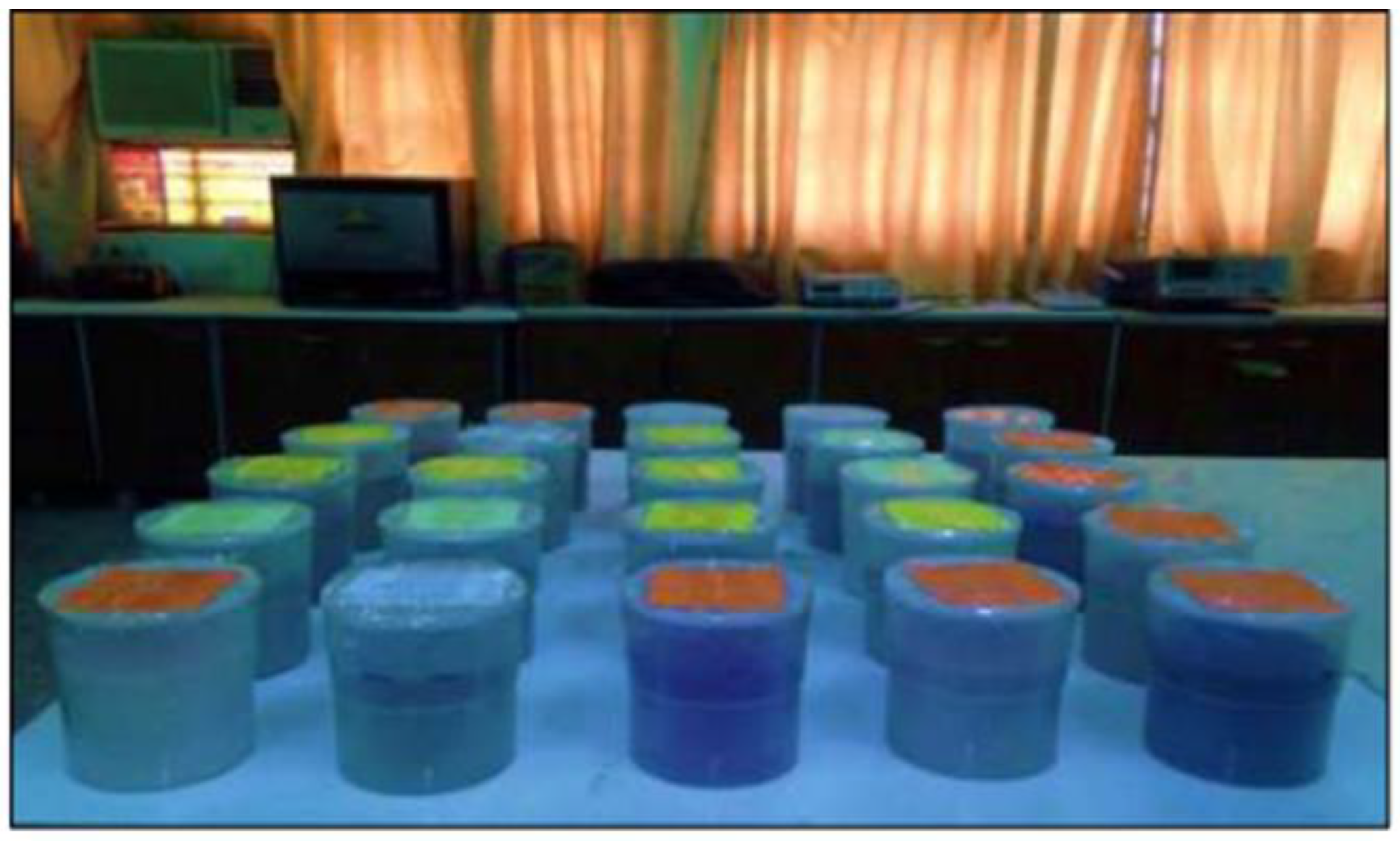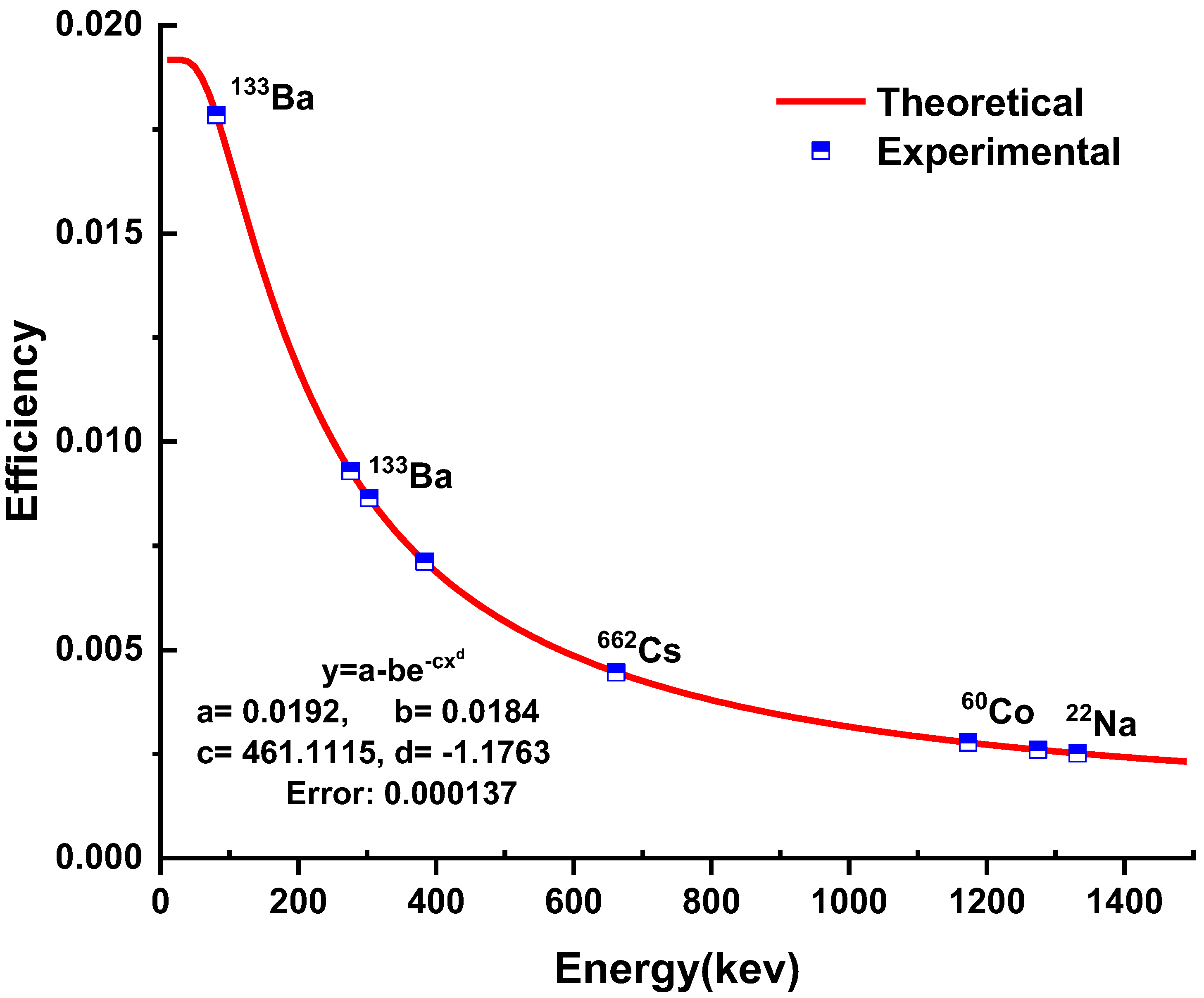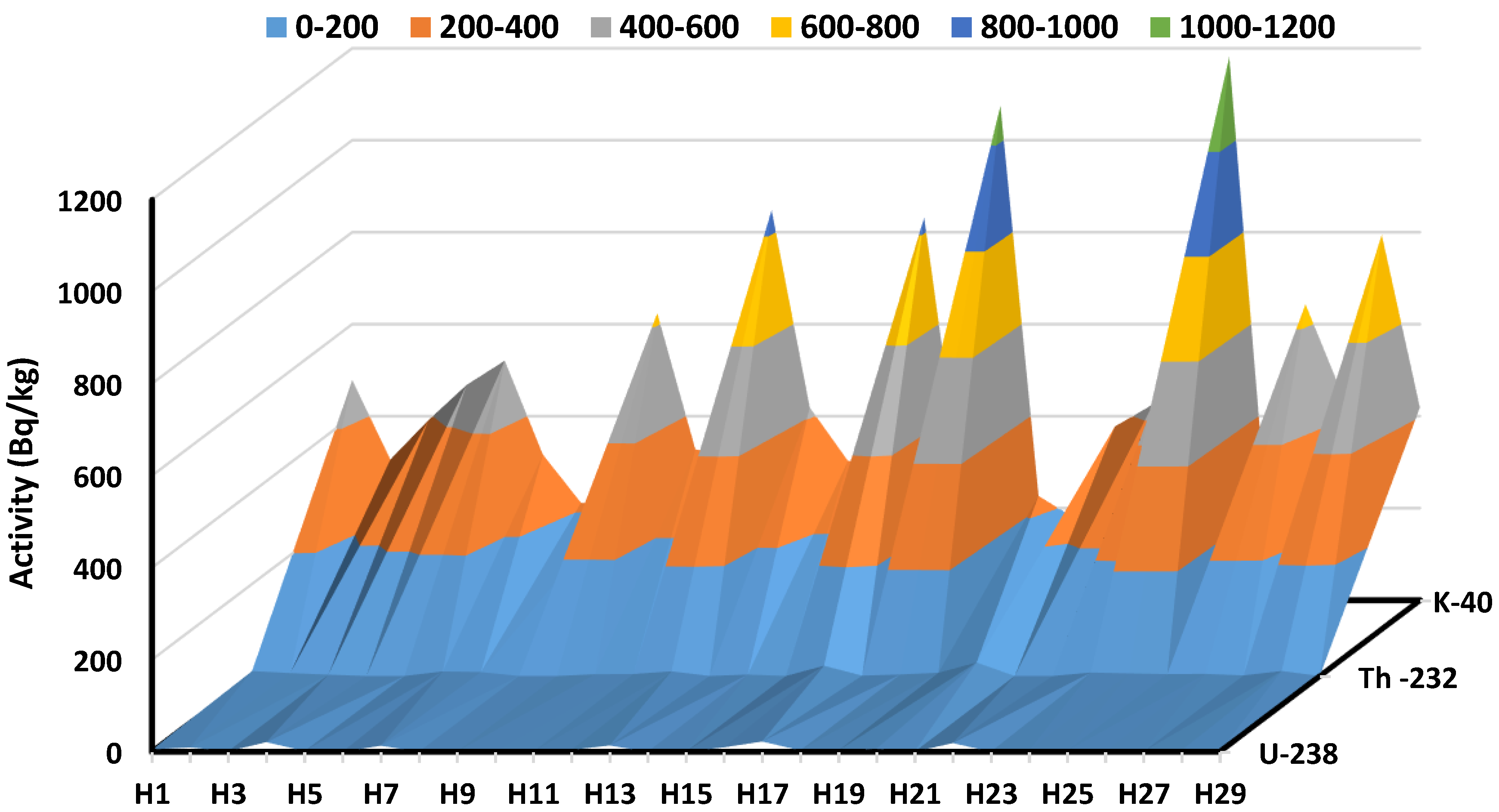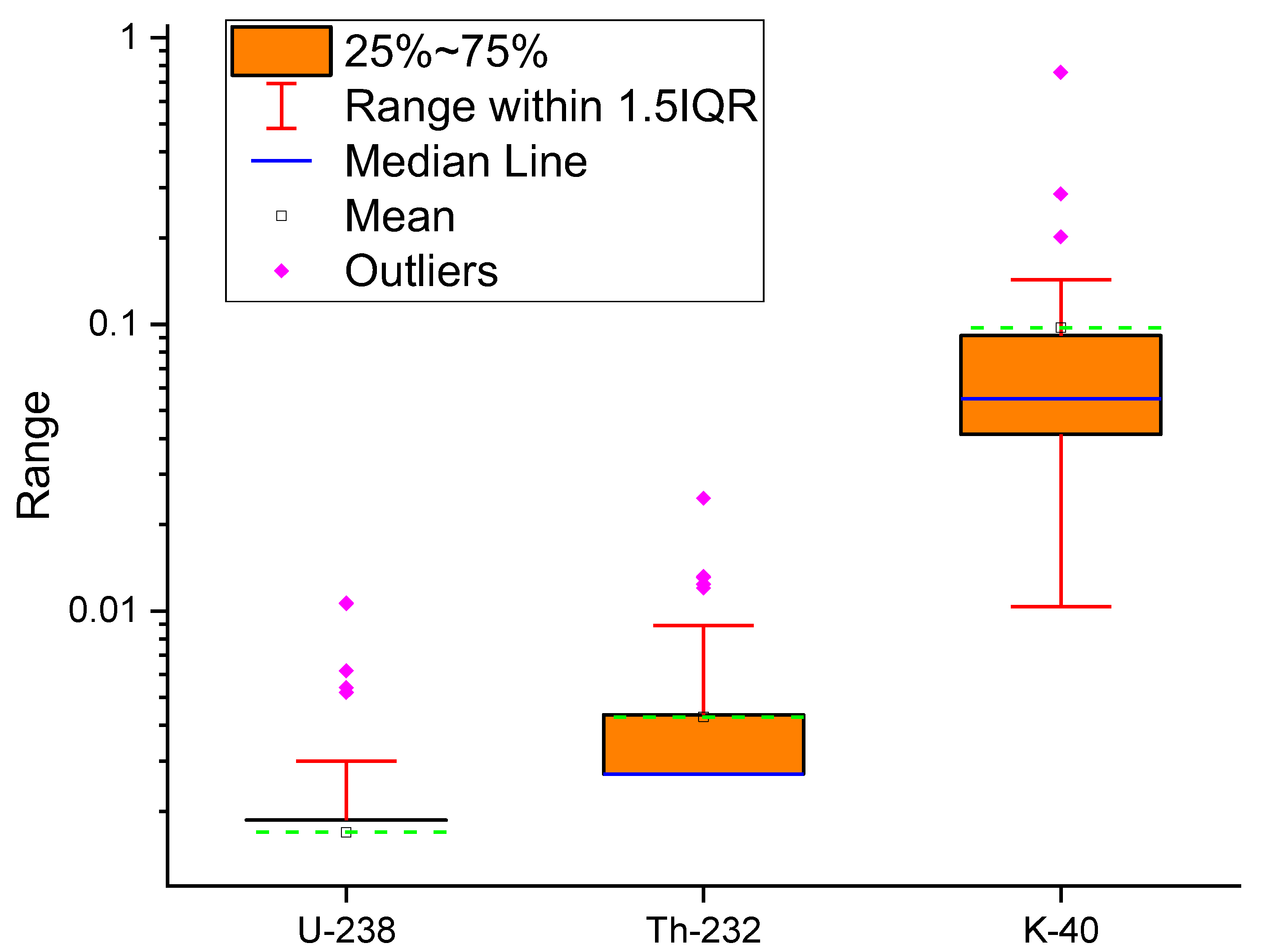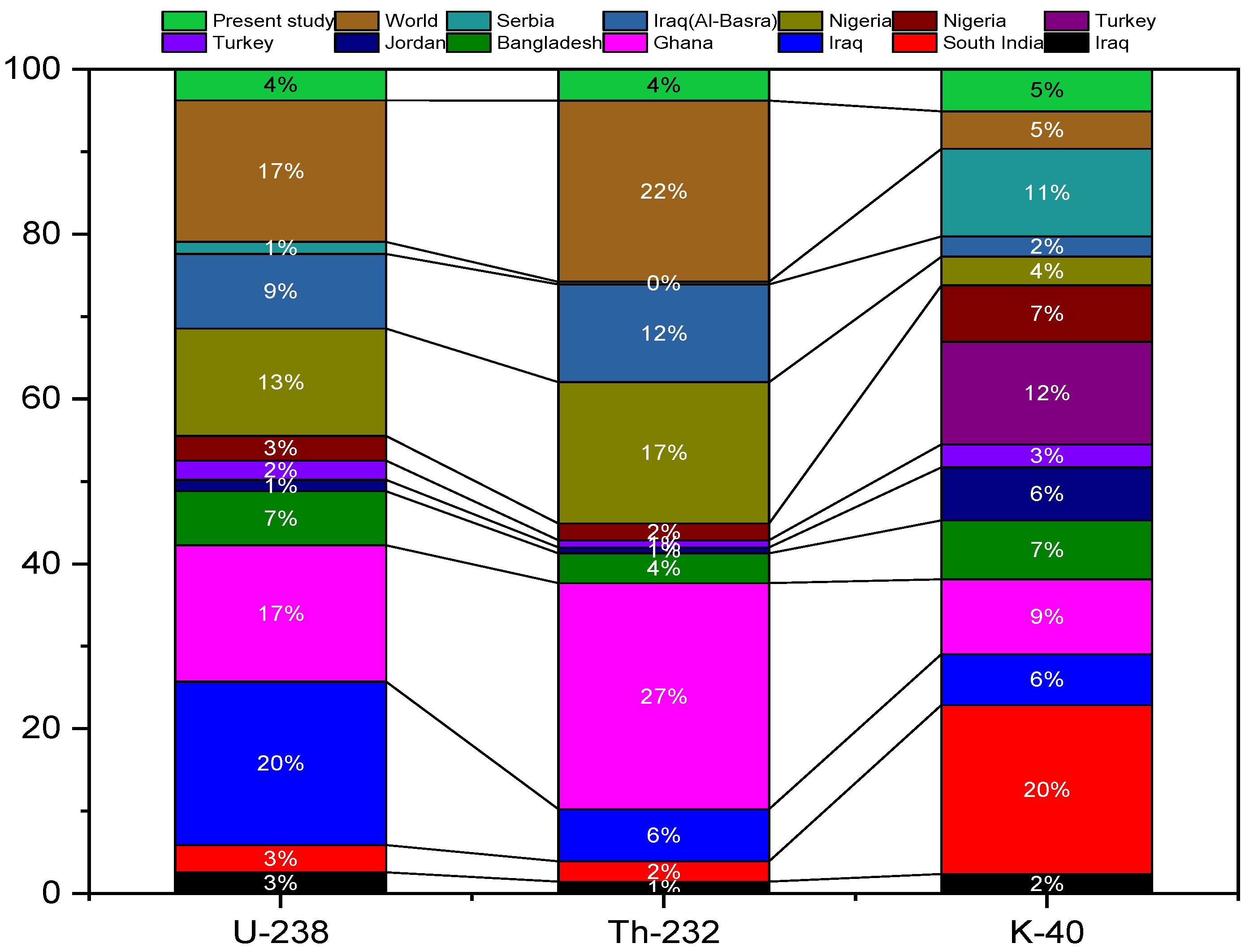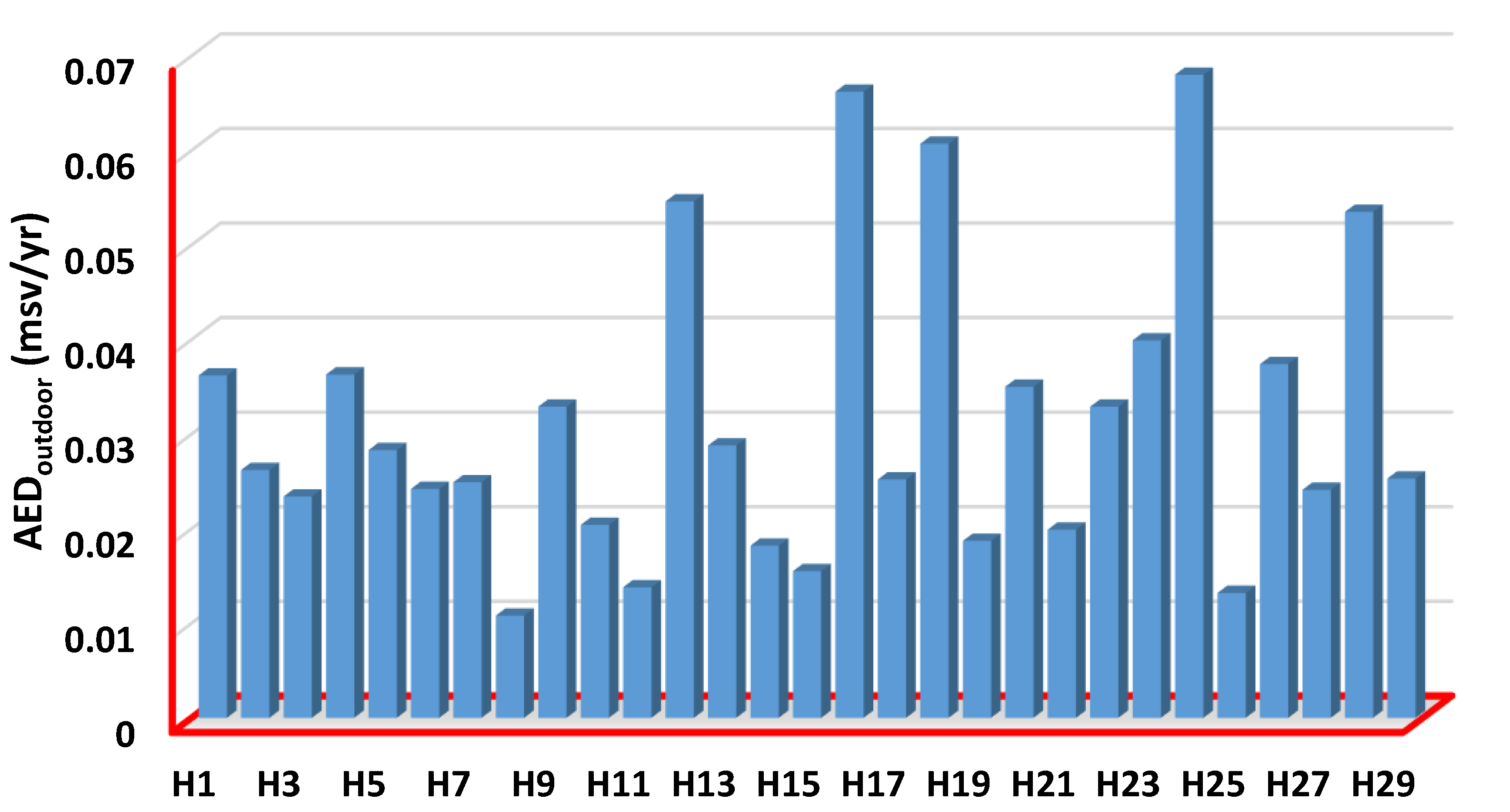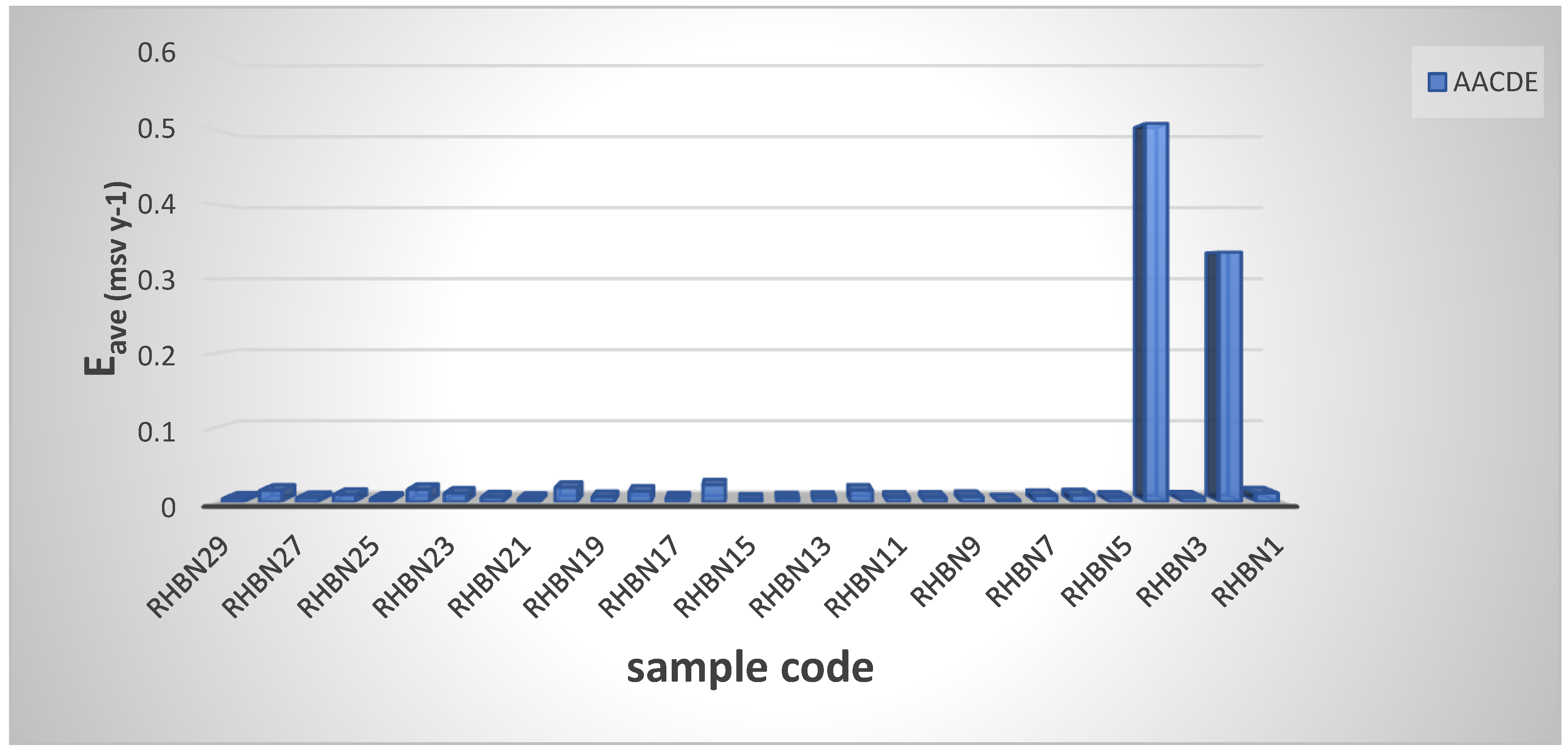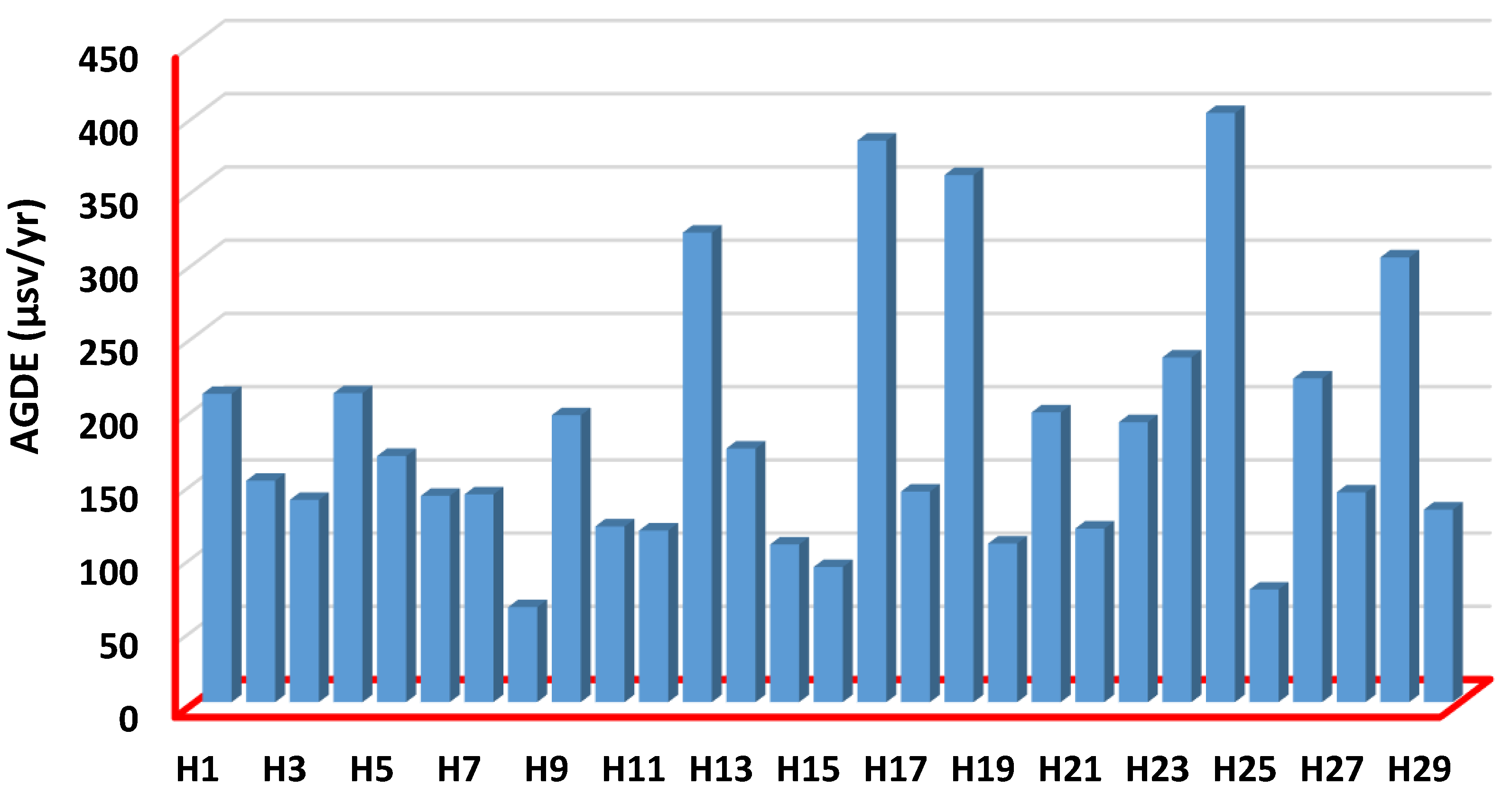1. Introduction
Many plants have been employed for nutrition and medicine since the dawn of human history. The study of the concentration of radioactivity in plants in the environment is relevant to ecological and plant evolution under certain geochemical conditions and adaptation and provides information for environmental radioactivity monitoring [
1,
2].
Radionuclides from the
238U and
232Th family, as well as
40K, are terrestrial primordial radionuclides that formed in the earth’s crust and are natural sources of radioactivity in the environment [
3].
Traditional medicine is defined by the World Health Organization as therapeutic techniques that have existed for hundreds of years before the establishment and spread of modern medicine and are still in use today [
4].The environmental conditions could affect the properties and efficacy of medicinal herbs, and one of the most significant parameters that should be controlled is the level of natural and artificial radionuclides. According to the WHO guidelines for herbal medicines’ quality regulation, the health risk posed by the accidental contamination of herbal medicines by radionuclides depends not only on the specific radionuclide and the level of contamination but also on the dose and duration of use of the product consumed [
5].
All over the world, medicinal herbs have been used for a long time [
6]. A growing number of people are turning to herbal medicine to enhance their health in recent years because of their well-known pharmacological as well as therapeutic properties of many of them [
7]. Seventy-five percent of the world’s population relies on herbs for basic health care, according to WHO reports [
8]. We are witnessing a global herbal that is taking place all over the world, with herbs containing medicinal properties being used in contemporary medical therapies as well. A plant’s most used organs are its leaves. Other organs include the flowers, fruit, seeds, stems, wood, bark, roots, and rhizomes. These organs are used as is or pulverized into a fine powder [
9]. Additionally, medicinal plant ethnobotanical research is a critical step in the local development of ecotourism, which includes environmental museums and small-scale businesses dealing with native medicinal and edible plants, as well as community-based bio-conservation initiatives. However, in order to complete all of these duties, the use of medicinal plants and their products must be strictly regulated in order to avoid any potentially harmful side effects on the health of consumers. Since plants are the principal conduit of natural radionuclides entering the human body through the food chain, radionuclides in soil may enter the food chain through direct deposition on leaves or transfer to portions of plants used for medicinal purposes. In addition, root uptake, direct deposition from the atmosphere, and resuspended natural radionuclide from the soil contribute to the absorption of soluble radionuclides in soil water. In soils and rocks, the naturally occurring radionuclides
226Ra,
232Th, and
40K are the principal radiation sources. Because of their gamma-ray emissions, these radionuclides constitute a danger of external exposure [
10].
Medicinal herbs’ properties and efficacy may be influenced by their environmental surroundings, and one of the most important parameters that must be monitored is the level of natural and man-made radionuclides present in them. Aside from the specific radionuclide and the level of contamination, the health risks posed by accidental radionuclide contamination of herbal medicines has been found to be dependent on the amount consumed and the length of time it was consumed [
5]. It is possible to accumulate harmful substances in the human body when using herbal remedies for a long period of time [
11]. An individual’s annual effective dose from ingestion increases because of increased concentrations of radioactive elements, increasing the risk of radiological harm because of ingestion. As a result, it is critical to research radionuclide absorption and activity distribution, as well as the possible human effective radiation dosage from therapeutic plants. Medicinal plants can be found in their natural state or processed.
Due to preparation techniques that invariably eliminate part of the radionuclides, NORMS (Naturally Occurring Radioactive Material) activity concentrations in herbal formulations are substantially lower than in raw plants. The health effects of NORMS (Naturally Occurring Radioactive Material) exposure from medicinal plants and herbal preparation ingestion concerning NORMS levels in medicinal plants may be linked to most types of leukemia and cancer [
12,
13]. The average annual effective dose from natural sources is 2.4 mSv worldwide—the average radioactivity ingested in food and drink results in a dosage of roughly 0.29 mSv
−1. Potassium, a vital nutrient, is the major radionuclide that contributes to the dosage. Potassium levels in the body are almost constant. Compared to uranium and thorium, thorium has a lower melting point [
14,
15]. K-potassium is the most important nutrients for plants. Because K and Cs are members of the same chemical element family, their attitude toward the plant’s metabolism is very similar to one another [
16]. Potassium, as well as its naturally occurring radioisotope
40K, enters the plant roots through ion channels, or transporters, that are also used for the Cs
+ ion transporter. As a result, a high K content in soil inhibits the adsorption of Cs, and the impact could be heightened by higher mobility of the potassium ion in soil, which increases the availability of potassium to plants [
17]. The purpose of this study was to provide information on: natural radionuclide activity concentrations in numerous medicinal plants; the radiation hazards related to the intake of therapeutic plants, as evaluated in this research.
3. Calculation of Radiological Hazard
The air-absorbed dose rate (
) was determined using UNSCEAR’s recommendations. The absorbed gamma dose rate
D (nGy/h) in the air at 1 m above the ground was measured to guarantee the homogeneous dispersion of radionuclides. This parameter may be used to measure any radiological risk and radiation exposure from radionuclides in the soil; the absorbed dose rate in air
Dout was determined using the formula [
32]:
where
is the dose rate in nGy h
−1 and
,
, and
are the activity concentrations (Bq kg
−1) of radium (
226Ra), thorium (
232Th), and potassium (
40K), respectively. Determining the ratio of the absorbed dose to the outdoor dose received from radiation emitted by radionuclides is a key step in health risk assessments.
The internally absorbed gamma dos (
Din) rate is expressed by Equation (6), and according to the UNSCEAR 2000 report, this internal dose should not exceed 84 nGy/h [
32].
The average annual committed effective dose (
AACED) for the ingestion of NORMs in medicinal plants is calculated using the expression:
where
is the average annual committed effective dose,
is the rate of consumption of intake NORMs from medicinal plants,
is the dose conversion coefficient for ingestion for each radionuclide (i.e., 4.5 × 10
−5 2.8 × 10
−4, 2.3 × 10
−4 and 6.2 × 10
−6 for
238U,
226Ra,
232Th, and, K respectively for an adult) [
33], and
isthe specific activity concentration of each radionuclide. Although there is no defined dosage for the use of medicinal plants, a rise in the rate of intake by a patient who utilizes these plants to treat an illness on a regular basis raises their average effective yearly dose Using the Formula (7), The average bound annual effective dosage for NORMs in medicinal plants is
[
33].
represents the annual consumption rate of NORMs in medicinal plants, which is 1.8 kg/yr [
1,
2].
For all the medicinal plants utilized in this investigation, it was assumed that a patient requires 100 mL/day of the herbal preparation or product throughout the treatment period or is 5%.
To assess the health effects of the absorbed dose, the annual effective dose should be calculated using a conversion factor (0.7
) to convert the air-absorbed dose to the effective dose received by humans, along with an external occupancy factor (0.2), which is equivalent to a 20% outdoor occupancy and an 80% inward occupancy [
34,
35].
This variable is appropriate for identifying the lifestyle in the research area [
36]. It can be used to compute the annual effective dose rate (
AEDR, in mSv/y) received by a population. This component is appropriate for identifying the life pattern in the research area. The population’s annual effective dose rate (
AEDR, in
) may be computed using the following equation [
37].
where,
is the total air absorbed dose rate in the outdoors; 8760 h is the number of hours in one year; 0.2 is the outdoor occupancy factor; 0.7
is the conversion coefficient from the absorbed dose in the air to the effective dose received by adults;
is the conversion factor between nano- and milli-level measurements. The annual effective dose rates (E) are an important parameter to consider when evaluating the health effects of an absorbed dose. The conversion coefficient from absorbed dose in the air to effective dose (0.7 Sv/Gy) and the indoor occupancy factor (0.80) proposed by [
13,
32] are used to estimate effective dose rates. The annual effective dose in millisieverts per year (mSv/y) was calculated using the following formula [
32].
The thyroid gland, lungs, bone marrow, gonads, and breasts are among the organs affected by atomic radiation. The amount of
AGDE produced in soil by the activity of
226Ra,
323Th and
40K is calculated as follows [
32].
The external hazard index (
Hex) produced by the emitted rays of the samples should be ≤1, which corresponds to the upper limit of
Raeq (370 Bp/Kg) [
38]. The
Hex external hazard index, expressed in (mGy/yr) is calculated according to the following equation
where
,
, and
are the activity concentrations of
226Ra, (
238U-series),
232Th, and
40K, respectively. The internal exposure
Hin to
222Rn and its daughter products are controlled by an internal hazard index
Hin, which is defined in [
39,
40].
The radioactivity level index used to estimate the level of gamma radiation hazard associated with different concentrations of some specific radionuclides is defined by the following equation [
21,
41,
42].
where,
,
, and
are the activity concentrations of
226Ra, (
238U-series),
232Th, and
40K, respectively. Even in the absence of radioactive components, miners, and inhabitants of the study region who are expected to spend the majority of their time in this environment, one may estimate carcinogenic potential using the lifetime cancer risk (
ELCR). Excess lifetime cancer risk (
ELCR) was determined based on the values of the annual committed effective dose using the equation
where LE is life expectancy taken to be 70 years and RF is a fatal risk factor per sievert which was 0.05 [
43].
4. Results and Discussion
Gamma-ray spectrometry was used to measure the radioactivity levels of NORMs in 29 different medicinal plants that are commonly used in Egypt. The equation used to figure out the average concentrations of
226Ra,
232Th and
40K that were used (3). Calculations were also used to figure out how much radiation these medicinal plants might cause. The risk indexes and annual effective doses were also considered. Results from our study were compared to global averages set by UNSCEAR and results from other countries. Our findings and comparisons are shown in the following logical order.
Figure 3 and
Table 2 show the average dry weight activity concentrations of
226Ra,
232Th and
40K for the medicinal plants that were tested in this study. Each sample and isotope being looked at has a wide range of activities. Different medicinal plants may have different concentrations of NORMs because they have different amounts of radioactive minerals and can absorb certain elements [
2].
From the current research, we can see that the concentration levels of
238U varied from BDL to 20.71 ± 1.52 Bq/Kg as observed in 15 plant species exceeding BDL values with an average of 7.25 ± 0.52 Bq/Kg. Thyme herb (H4) has the highest
238U concentration.
232Th concentrations ranged from BDL to 29.35 ± 1.33 Bq/Kg, as observed in 10 plant species with with concentrations greater than BDL values, with an average of 7.78 ± 0.633
. Cinnamon (H20) has the highest
232Th concentration. The
40K activity concentrations were recorded between 172 ± 5.85 Bq/Kg turmeric and 1181.2 ± 25.5
cinnamon with an average value of 471.4 ± 11.33 Bq/Kg. Since some of the studied samples have been imported from different regions, the detected activity values of radionuclides were affected due to different levels of natural radioactivity in the soil and environment in those countries. Nevertheless, based on the findings, the specific activity values of
238U were within the limit of 33 Bq/Kg in all samples [
32].
Furthermore, it was discovered that the specific activity levels of
232Th in all samples were within the range of 45 Bq/Kg [
32]. Except for a few samples that were more extensive than the permissible value of 400 Bqkg
−1 [
32], the values of the activity concentration of the
40K are less than the allowable value of 400 Bqkg
−1. Since typical radionuclide activity heights are not regulated across the ground and due to the flowers’ ability to absorb more basic features than others, differences in the concentrations of activity could be attributed to changes in the physical location of the plants and the radiochemical action of the lands in which these medicinal plants are developed or cultivated. The increased potassium activity in these plants might be related to the plants’ effectiveness in absorbing potassium as well as other components from the soil [
44].
Figure 4 shows the range, mean, median line, and outliers’ radioactive elements for measured samples in the region of interest. The current study’s activity concentration findings were compared to the published data in
Table 3 for a selection of medicinal plants found in the literature, as shown in
Figure 5. This comparison shows that the current findings are relatively consistent with those measured in other nations using the global values indicated in the UNSCEAR 2000 report.
In a real sense, the current results show that the amount of
238U in the air is much higher than in Iraq [
45], South India [
46], Jordan [
49], Turkey [
50], Nigeria [
53], Serbia [
54], Turkey [
51], and lower than amounts obtained in Iraq [
47], Ghana [
2], Bangladesh [
48], and Nigeria [
53]. The results of
232Th show that our result is higher than the results found in Iraq [
45], South India [
46], Nigeria [
52], Jordan [
49] and Turkey [
50] and is lower than the results found in Iraq [
47], Ghana [
2] and Nigeria [
53]. Our findings in the case of
40K are significantly greater than those from Iraq [
45], Turkey [
50] and Nigeria [
53] but significantly lower than those from Iraq [
47], South India [
46], Ghana [
2], Jordan [
49], Nigeria [
52] and Turkey [
51].The discrepancies in natural radioactivity concentrations between countries might be explained by the raw material sources (
Figure 5).
The measured outdoor annual effective doses (
AEDoutdoor) values for examined herbs have been listed in
Table 4. The values ranged from 0.0108 ± 0.0032 to 0.0680 ± 0.0097 mSv/yr, with the mean value of 0.0315 ± 0.0084 mSv/yr. Lemon Balm (H8) and Worm Wood (H24) herbs have the lowest and highest
AEDoutdoor among all herb samples (
Figure 6). The
AEDoutdoor results are smaller than the corresponding global value of 1 mSv/yr. The measured indoor annual effective doses (
AEDindoor) values for examined herbs have been listed in
Table 4. The values ranged from 0.0810 ± 0.0032 to 0.5053 ± 0.0097 mSv/yr, with the mean value of 0.236 ± 0.0084 mSv/yr. Lemon Balm (H8) and Quince (H23) herbs have the lowest and highest
AEDindoor and
AEDoutdoor among all herb samples (
Figure 6 and
Figure 7). The
AEDindoor results are smaller than the corresponding global value of 1 mSv/yr. 0.0919 ± 0.0036, 0.555 ± 0.024, and 0.267 ± 0.0095 mSv/yr are the minimum, maximum, and average total annual effective dose (
AEDtot) values for all investigated herbs, respectively. Lemon Balm (H8) and Lavender (H16) herbs have the lowest and highest
AEDtotalr among all herb sample values for all investigated herbs, respectively. According to the NSRC and the International Atomic Energy Agency (IAEA), the annual effective dose equivalent for all tested herbs is less than the annual dose limit of 1 mSv for the general population.
Table 4 and
Figure 8 represent the minimum, maximum, and mean annual effective doses (AACDE) values due to the intake of
238U,
232Th, and
40K radionuclides through eating the medical plants (herbs), which were equal to 0.002304 ± 0.000091, 0.50869 ± 0.00024, and 0.0373 ± 0.00040 mSv/yr, respectively. Lemon Balm (H8) and Worm Wood (H24) herbs have the lowest and highest AACDE among all herb samples. The AACDE values were lower than the global average (0.3 mSv/yr) for natural radionuclide ingestion reported in the UNSCEAR 2000 report [
32].
Table 5 compares our AACDE to those assessed in Egypt [
55], South India [
46], Ghana [
2], Iraq [
47] and Thailand [
56]. According to the comparison, our result is smaller than that of Egypt [
55], and the amount of AACDE is higher than that South India [
46], Ghana [
2], Iraq [
47], Turkey [
57] and Thailand [
56]. These figures are all considerably lower than the global average dose [
32]. As a result, the medicinal plant samples tested here are radiologically safe for adult consumption and pose no risk to human health. According to the findings, there are no radiological health concerns associated with the use of these materials.
The annual gonadal dose equivalent (
AGDE) for medicinal plants is shown in
Figure 9 and listed in
Table 4.
AGDE values range from 402.2 ± 11.3 to 64.8 ± 2.57 µSv/yr with an average of 185.1 ± 6.48 µSv/yr. All values are less than their corresponding global value of 300
[
32], except for Worm Wood (H24). These measurements provide information on the local drugs, in order for these models to be used to formulate guidelines related to radiological health care.
The outdoor absorbed dose rate (
Doutdoor) values have been estimated for the medicinal plants’ samples, as shown in
Table 6. It was found that the values of the
Doutdoor vary from 55.46 ± 1.59 to 8.87 ± 0.35 nGy/h with a mean value of 22.75 ± 22.75 nGy/h. The lowest value was found in the sample Lemon Balm and the highest value in the Worm Woodsample. The values of the absorbed dose rate for all samples were less than the permissible level of 84 nGy/h; according to UNSCEAR, it has been recommended that the average exposure rate of the population should be within 84 nGy/h, while the indoor absorbed dose rate (
Dindoor) values ranged from 103.01 ± 1.98 to 16.52 ± 0.65 nGy/h, with an average value of 48.183 ± 1.71 nGy/h. The lowest value was found in Lemon Balm and the highest in a sample Quince. The values of the absorbed dose rate for all samples were less than the permissible level of 84 nGy h
−1. According to UNSCEAR, the population’s average exposure rate should be kept below 84 nGy/h.
According to UNSCEAR, the average indoor absorbed dose rate values for all samples are below the permissible level of 59 nGy h
−1. The external and internal hazard indexes are shown in
Table 6, and their maximum values are 0.287 ± 0.013 and 0.3099 ± 0.015, respectively. At the same time, the minimum values were 0.0429 ± 0.0017 and 0.0429 ± 0.0017, respectively. The average values were 0.1322 ± 0.0050 and 0.1448 ± 0.0059. For all types of medicinal plant samples evaluated in this study, the calculated values of extrinsic and intrinsic risk indices were less than one [
32]. Therefore, there should be efforts to reduce the annual effective dose to ≤1.5 mSv for the safe use of these plants, because of the calculated radioactivity level index in
Table 6. The values ranged from 0.860 ± 0.024 maximum value in Worm wood sample to 0.1376 ± 0.0054 minimum value in the Lemon Balm sample, with an average value of 0.399 ± 0.0142. All values of the calculated radioactivity level index (Iγ) for the samples were checked, and were below the permissible levels [
32].
Excess lifetime cancer risk (
ELCR) values ranged from the maximum value 1.7804 × 10
−3 ± 0.0008 in Thyme herb to the minimum value 0.00806 × 10
−3 ± 0.003 in Lemon Balm, with an average value of 0.1307 × 10
−3 ± 0.00142. Based on the annual exposure limit of (1 mSv) for the general population set by UNSCEAR, ICRP [
32,
58], the mean value of ELCR is less than the global average of 2.9 × 10
−4 as shown in
Table 7.
